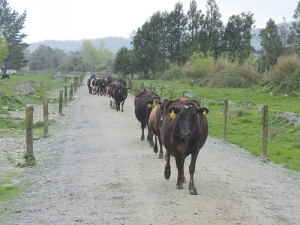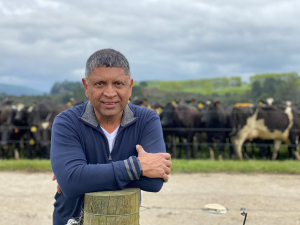Managing a successful mating relies on achieving key mating targets throughout the year.
There are eight key management areas that will need to be considered to achieve a successful mating. These are well described in the DairyNZ InCalf programme.
Four of these factors are within your direct control at mating time and the others will need to be managed throughout the year.
Heat detection, non-cycler strategies, AB and genetics and service bull management are controlled within the mating period.
Calving pattern, heifer management, body condition score and nutrition and cow health need to be managed well at other times of the year as they will also impact on the success of mating.
Mating Time
Heat Detection:
The art of picking cows on heat and deciding when to submit them for insemination.
Training: staff need to know the signs of heat and the process for dealing with the bulling cows well before the season starts. Make use of industry training days and the pre-mating period to ensure everyone is up to speed with heat detection skills.
One important thing to consider when assessing heat detection performance is whether the right cows are being submitted at the right time. The 'right cow' is any cow that is on heat. The 'right time' is when she truly is on heat.
Effective heat detection requires prolonged focus and attention to detail, making sure you don't miss any cows on heat and making sure you are not 'inventing' heats either. After mating has passed it is important to review these two figures to decide how to manage the rest of mating. The question to ask is 'Have I put enough cows up and were they the right ones?'
Nationally, submission rates average 80%; the industry target is 90%. Submission rate is a key driver of in-calf rate; without submitting cows to AB or the bull they can't possibly get in calf. Review your submission rate; if you haven't reached 90% ask yourself 'Which are the cows that didn't get submitted and why?' Were they early or late calvers, old or young, healthy or unwell, at body condition score target?
Once you've identified the cows that missed being mated you can start to uncover why and set solutions in place to address issues.
You can measure your performance on your herd recording software: look at the 3-week submission rate graph for submission rates of the herd and sub-groups within it and the return intervals analysis graph to check when they returned to service and see if you were inventing heats. Average or normal return length for a cow is 18-24 days: most returns should be within this range.
If there is a high percentage of 2-17 day returns the first thing to do is review heat detection policy.
Heat detection performance is extremely important, is measurable and is estimated to have room for significant improvement on 25% of New Zealand dairy farms. Consult your rural professional for more advice.
Non-cycling /Anoestrous cows:
While the treatment of non-cycling cows is the focus at mating time, other farm factors influence the rate of non-cyclers in the herd. The most important part of addressing non-cycling issues is to identify and address the underlying causes. The cows most at risk of being non-cyclers are young cows, thin cows, late calvers and cows that have been sick. Reducing the percentage of these in the herd should result in fewer non-cyclers. Aim to have 85% of your herd cycling by mating start date.
There are two types of non-cyclers: cows whose heat has gone undetected and cows that have not started ovulating since calving so have not had a heat.
Treatment of both groups will be beneficial to lifting the herd's 3-week submission rate.
Conceiving early in the mating period is the ultimate aim so any intervention that needs to be done should be as early as practicably possible. Depending on when the cows that have been treated return, check that there is a strategy in place to manage these.
For example if you CIDR a large number of cows, clearly identify which these cows are by recording them on your herd records so you can analyse their performance. At the time of returns make sure your AB technician is aware of likely numbers of returns or that there is sufficient bull power in the herd on those days. Further information is in the InCalf book on page 181.
Non cycling management is important to get right at this time of the year, however be aware of the farm factors that influence intervention rate. Analyse which are your non-cyclers, treat them early and set about changing management policies to avoid future high intervention rates.
Bull management:
Managing bull mating is not only important when the bulls are in with the herd but before they actually arrive onfarm. Important things to consider: age, breed, health, numbers, arrival date on farm, plus a contingency plan in case issues arise. Good bull management will ensure your successful mating performance continues into the natural mating period.
If possible bulls should arrive on farm two-three months before they are required for work, with a certificate of health, fully vaccinated and free from BVD, lepto and other ailments. If bulls become sick and run a fever semen quality is affected and it takes 60 days for the semen to rejuvenate and for the bull to become fertile again. It may turn up looking healthy, however his recent past history is unknown. Arriving onfarm early has other benefits: it gives the mob of bulls time to establish their pecking order and for you to observe behaviour and rid the mob of overly dominant or dangerous bulls.
There are several things to consider when managing the bull mating period including bull power and bull health. To estimate bull numbers refer to the table on page 129 of the InCalf book. For example, a herd of 400 cows with a likely in-calf rate of 50-70% will need 5-6 bulls running with them at any time.
It is very important to rotate bull teams to keep them refreshed and their semen viable. Your vet can check testicular size and shape as this is highly correlated to semen functionality and fertility.
Bull management is important to minimise final empty rates. Know your bulls, know their performance.
AB & Genetics:
As long as you are using NZ genetics the herd's inherent fertility is unlikely to be a problem, as fertility is included in BW and NZ genetics rank highly for reproductive performance internationally.
AB practices should be best practice and include appropriate semen handling and storage, correct pipette placement when performing AB and accurate recording practices. AB companies have internal semen quality monitoring processes to ensure the semen delivered is fit for purpose and they have software to alert to inbreeding issues.
DIY has a recognised risk factor, so DIY inseminators are encouraged to regularly attend refresher courses to refine their practices. Australian research found that at least 40% of DIY inseminators could achieve higher conception rates by improving insemination practices (InCalf book pg 111)
Outside the Mating Period:
Cow health must be maintained in an optimal state for good cow performance all year, including at mating time. Have a robust animal health plan in place for your herd. The size of the impact of individual illness on herd reproductive performance is determined by the percentage of cows affected and the degree of the impact on their fertility. Good recording and management of health events will allow you to assess disease incidence and impact and make a plan to avoid the issue in future years. Ensure all your cow health events are recorded on your herd records. This gives you an insight into their impact on performance. While uterine disease often has a significant impact in affected cows, mastitis and lameness can also impact mating outcomes.
Remember to implement prevention strategies if: more than 2% of herd has retained membranes, 1% have vaginal discharge two weeks after calving, 10% have clinical mastitis or 5% in one month or 5% of cows are treated for lameness issues. By using prevention strategies you will minimise the impact on in-calf rates so seek veterinary advice.
Calving pattern has a very strong influence on subsequent in-calf rates. Having more than 13% of your herd calving after week 6 of calving (ie.late calvers) is a drag on your subsequent mating performance. Late calvers have less time to get in calf, and usually have reduced submission and conception rates compared to their early calving herd mates. On top of that they have fewer days in milk, and fewer milk solids produced compared to early calvers. Herds with less than 13% late calvers are more likely to find achieving a compact calving easier than those with a high percentage of late calvers. Ensuring first calvers calve down quickly into the herd and minimising calving pattern slippage in subsequent lactations is a fundamental principle of achieving sustainable herd fertility in seasonal systems.
Body condition score: meeting body condition targets at calving is a key driver of production and reproduction in the season that follows. It is largely determined by decisions made at dry off time, and over the winter period. There is little you can do to change this at mating time. Manage feed quantity and quality at mating time but consider drying off based on body condition score and calving pattern in the months to come. This will ensure cows calve down at the required 5.0 for mature aged cows and 5.5 for heifers. Body condition score loss between calving and mating is also important; ensure cows don't lose more than 1.0 BCS post calving. Cows that don't calve at the required BCS target and lose too much post calving produce less milk solids and take longer to cycle.
Heifers are the future of your herd. Well grown and managed heifers are likely to produce more, have better reproductive performance and survive in the herd than poorly grown animals. Make sure your heifers are regularly weighed, monitored and managed to meet their liveweight BV based targets once they calve down in the herd. Monitor heifer weights and pre-mating cycling activity so you can intervene if necessary to address issues with undergrown heifers. Options include hormonal intervention, putting heifers on once a day, preferential feeding and running them in a separate mob to reduce competition from the older cows.
There are many factors to consider when managing mating, but these eight areas are key.
Measure your herd's performance. Find the areas of improvement and make a plan to maximise your performance not just for this season but for seasons to come. For specialist help, consult a rural professional


















